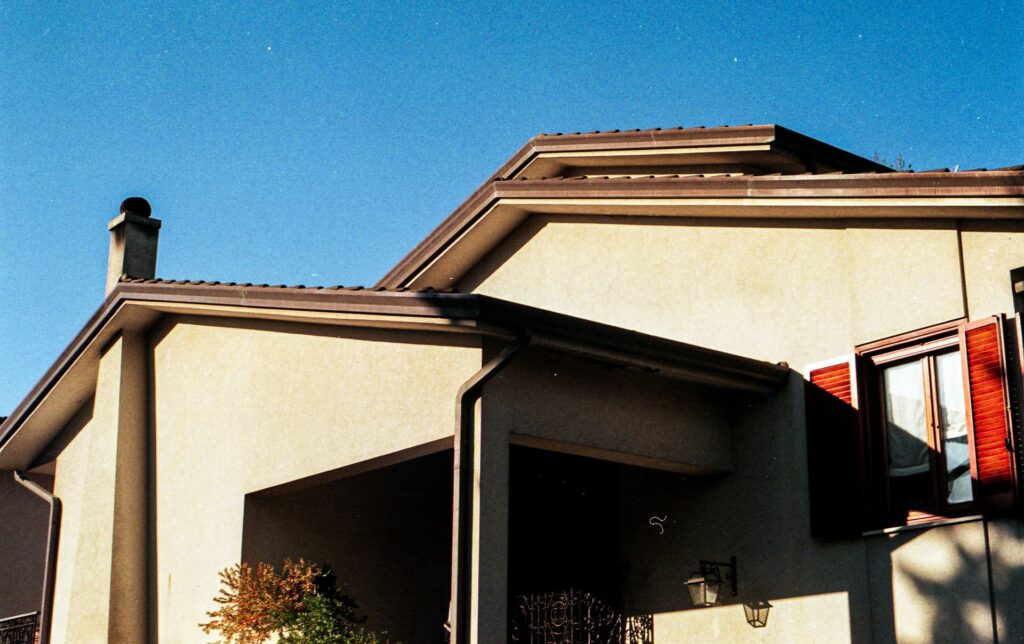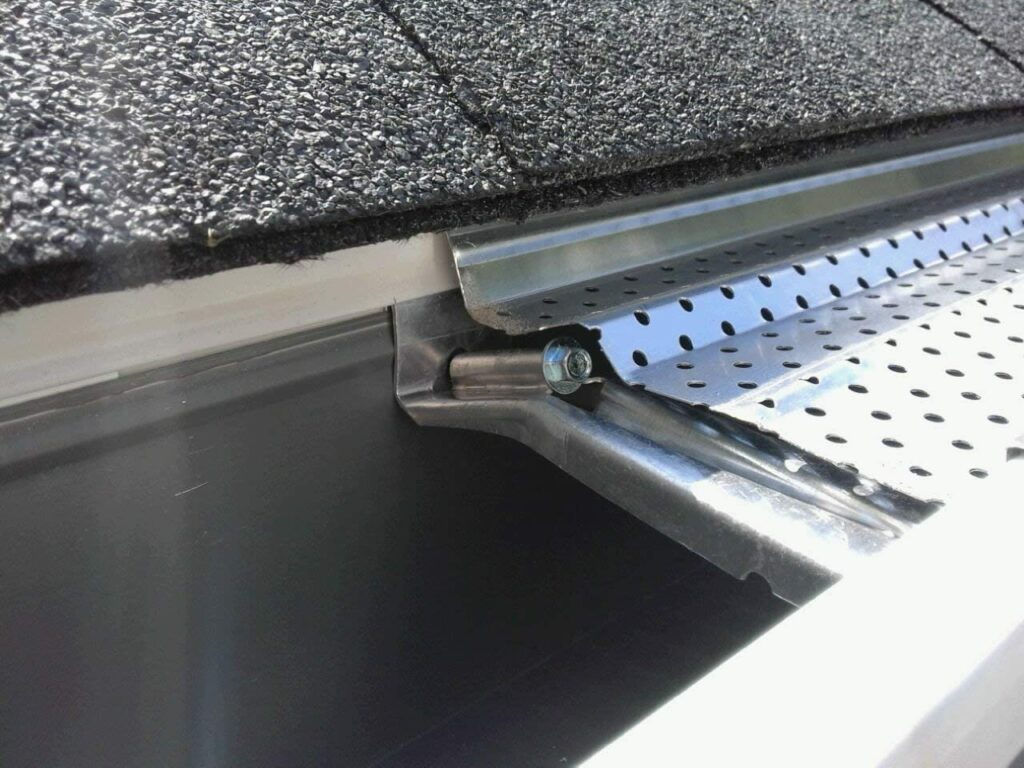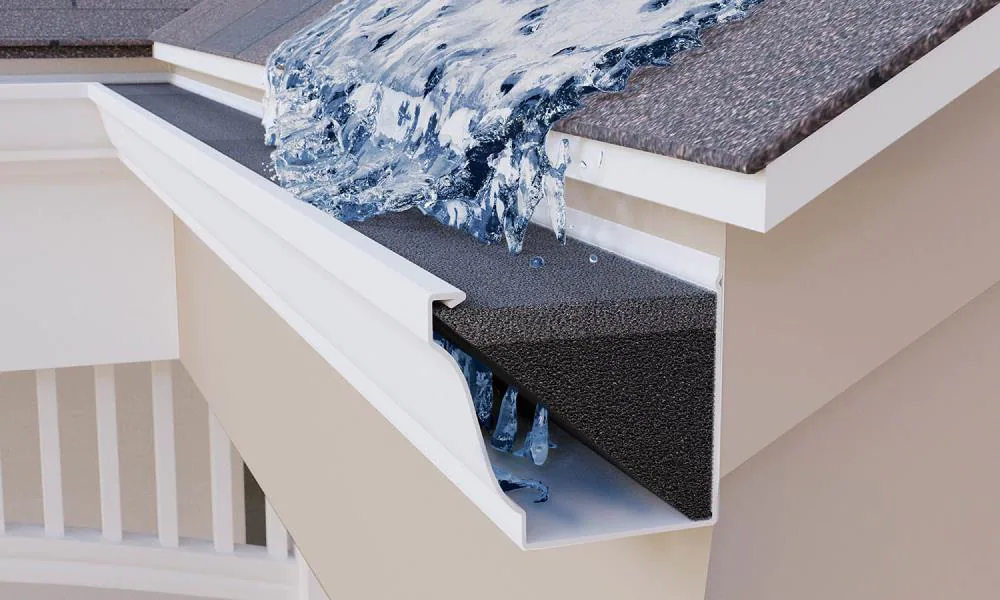
10 Sep The Best Gutter Guards Guide

Related: How to Modernize Your Home
Types of Gutter Guards

There are five types of gutter guards: micro-mesh, screen, brush, reverse curve, and foam. But what’s the difference? How can you know which one is the best for your home? Let’s dive a little deeper into the different types of gutter guards and the advantages and disadvantages of each so you can make an informed decision when you’re ready to make the investment.
Micro-Mesh
Micro mesh gutter guards will block bigger pieces of debris like twigs and pinecones while still allowing water to flow through the small holes. Pricing for these can vary depending on the material they’re made out of, whether plastic or strong stainless steel. They are relatively easy to install through one of three simple installation techniques. As far as maintenance goes, these may require some occasional cleaning with a hose and scrub brush to clear out smaller and more fine debris.
Screen
Screen guards are made from a wire or plastic grid that blocks debris like leaves from falling into the gutter trough. These are the easiest to install – you may not even need any tools! Simply lift the bottom row of shingles and slide the guard underneath them. Before you do that, check with your shingle manufacturer to ensure this won’t be a liability to the roof’s integrity. However, since these aren’t screwed in, they will not hold up in extreme weather. Heavy winds or falling tree branches may dislodge a screen guard.
Brush
Think about a brush gutter guard like a giant pipe cleaner that sits on the inside of your gutter and prevents all the gunk and junk from getting in there. They’re made out of a wire surrounded by polypropylene bristles, and they’re relatively inexpensive and easy to install, making them a popular choice for DIYers. To install them, cut the brush to the length of the gutter and slide it right in. The best part about these is that the wire is flexible, so if your gutters have a unique shape, the brush can be bent to fit them.
Reverse Curve
Made out of lightweight metal or molded plastic, this type of gutter guard allows water to flow over the top and around a downward curve before entering the gutter beneath. What ends up happening is that the debris just slides right off the edge onto the ground. These work well, even in areas with many trees, but they are more expensive and should be installed by a professional.
Foam
A foam gutter guard is a triangular-shaped slab of foam that sits in the gutter with one edge facing the back of the gutter, one edge facing the top to stop debris from getting in, and the final side-lying diagonally across the bottom to let water flow underneath. This is another popular choice for DIYers because they’re inexpensive and simple to install, but if you live in an area that gets a lot of precipitation, these may not be the best choice for you. Heavy amounts of rain can saturate the foam and make the gutters overflow.
What Should You Be Thinking About When Choosing the Best Gutter Guard?
Now that you know the different types, how do you know which one is right for you? What are some things to look for when shopping for gutter guards?
The Material
What the guard is made of can influence the price as well as the quality, so it’s essential to balance what you’re willing to spend with the quality you would want and expect for your home.
Copper
Since copper is highly resistant to rust and corrosion, it’s a good choice for manufacturers of micromesh and screen guards – but for a price. Copper doesn’t come cheap, but you’ll get your money’s worth out of them because of their resiliency. However, not a lot of manufacturers make gutter guards with copper.
Stainless Steel
Stainless steel is pretty durable and easier to come by than copper, so you’ll find many manufacturers of micro-mesh, screen, and reverse curve guards using it. Since it won’t rust, corrode, or warp, you can be confident that it’ll hold up well, but you’ll be paying a little more for stainless steel because of its durability.
Aluminum
Affordable and lightweight, most micro mesh and screen guards are made from aluminum. It’s not as tough as stainless steel, but as long as you don’t live in a heavily wooded area with potential for a lot of heavy debris, it could be a great, affordable choice.
Plastic
Plastic is inexpensive and resistant to corrosion. It’s important to remember that plastic is also prone to warping, swelling, or cracking.
Foam
When it comes to foam gutter guards, foam is surprisingly durable, but the downside is that it can be susceptible to mold.
Related: How Much Does it Cost to Paint a House in 2021
The Size
You’re going to have to get up on a (secure) ladder to measure your gutters. You’ll need to know the width (from inside edge to outside edge) and the length of your gutters, so you know what size guard you’ll need and how many gutter guards you’ll need to purchase to protect the entirety of the system. Most guards come in lengths of 3-8 feet and 5 inches wide (however, you can also buy them in widths of 4 and 6 inches).
Do you have DIY jobs to do around your home but are not sure how? We’re passionate about home renovation and design. Check out our resources at Nestrs.
Visibility
Consider the aesthetic of your home before investing in a gutter guard. If you’re super particular about the exterior of your home, make sure you choose a gutter guard system that will easily blend into your home. Since foam and brush guards sit inside the gutter, they’re pretty much invisible from the outside. However, micro-mesh, screen, and reverse curve guards are visible, and they tend to come in black, white, or silver. Our advice is to choose a color to match the roof.
DIY or Call a Pro
Most of these can be done with relative ease if your home is one story without hiring a professional. But if you have a two or more story home, consider hiring a professional with a proper ladder and experience working on high surfaces. Remember: any time you get on a ladder, you should have safety measures in place, like a spotter and a fall-safety system to prevent a catastrophic injury.
Warranty
DIY guards, especially foam and brush guards, don’t usually include a warranty because they’re designed to be temporary. But in considering warranties, don’t just think about the gutter guard itself, also think about your roof! If you have to move your shingles or make any changes to your roof when installing the guards, be sure it doesn’t void your roof warranty should the installation of a guard affect the integrity of your roof.
Our Top 3 Choices
Ready to start shopping? Here are our top three choices for gutter guards!
MasterShield Micromesh
MasterShield Micromesh Gutter Guard
If you’re ready to splurge and have a pro come out and install a gutter guard for you, MasterShield guarantees that once their product is installed, you’ll never have to clean your gutters again. Their gutter guards are designed to be pitched with the roof, and they don’t just keep debris out; they filter out and eliminate the growth of microorganisms in the gutter. A decade of research went into developing their product, so we’d say it’s well worth the investment.
Aluminum Gutter Guards

A-M Aluminum Gutter Guard 5″ (200′, Mill Finish)
This product has a lifetime warranty and a manufacturer’s guarantee that it won’t rust or deteriorate. Easy to install, durable enough for heavy rains, and virtually invisible from the ground, this guard has a screen that lays on top of your gutters and stops debris from getting in while letting the water flow through the holes.
Foam
GutterStuff GS10957 Foam Gutter Filter Insert with Year-Round Leaf Protection & Easy DIY Installation, 8 x 4′ (32-feet), Ft
This foam wedge easily slides into the gutter and comes in a variety of sizes, so you’re sure to find the right size for your home. The foam keeps debris out of the gutter without impeding the flow of rainwater.
Related: What to Look For When Buying a House: A Beginner’s Guide
Gutter Guards in a Nutshell
So what can gutter guards do for you? They help keep out the debris that can clog up your gutter and prevent water from properly flowing, which could cause real damage to your home. They can also keep out rodents, bugs, and other nuisance pests that may think your gutters make the perfect nesting site. By installing a gutter guard, you’ll significantly reduce the amount of maintenance required on your gutters and eliminate the need to climb on a dangerous ladder. With many different options ranging in cost and ease of installation, we think a gutter guard of any kind is a valuable and necessary investment to any home!
Do you love home renovation? Explore some of our resources and learn how to transform a dull home into an experience you and your family will love. Check us out at Nestrs for more information.



No Comments